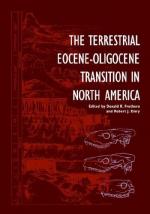|
This section contains 814 words (approx. 3 pages at 300 words per page) |

|
The Oligocene epoch (39 to 22 million years ago) is the transition period between the earlier and later Tertiary period (65 to 2 million years ago).
A key feature of evolution is the ripple effect created by geographical changes that influence climate and therefore vegetation and ultimately the ways in which animals develop. The most important geographical event separating the Oligocene from the preceding tropical and fairly stable Eocene was the splitting off of the Australasian landmass from Antarctica. As the oceans encircled the growing polar ice cap, the waters cooled. This cooling effect was spread around the globe by circulating currents that produced a dramatic drop in temperatures and, equally important, a new climate marked by seasonal fluctuations. Many animals of the Eocene that depended on a warm climate became extinct in the Oligocene, which is sometimes called "the great divide." Changing seasons favored the rise of homeothermic (warm-blooded) animals, such...
|
This section contains 814 words (approx. 3 pages at 300 words per page) |

|


